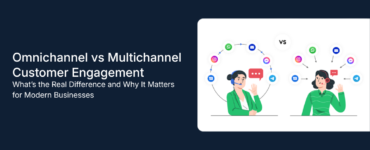Delivering a consistent and seamless brand experience across every customer interaction has become a key differentiator in competitive markets. This guide to omnichannel customer journey strategy explores how businesses can meet rising consumer expectations by unifying digital and physical touchpoints. Research by Salesforce shows that 88% of customers consider the overall experience just as important as the product or service itself. Moreover, Omnisend reports that campaigns using three or more channels see a 287% higher purchase rate compared to single-channel efforts. These insights highlight the growing need for brands to design journeys that are cohesive, personalized, and data-driven across all platforms. This article will walk you through the essential steps to understand, implement, and optimize an omnichannel strategy that truly aligns with customer behavior.
What Is an Omnichannel Customer Journey?
A well-executed guide to omnichannel customer journey strategy begins with understanding how customers interact with a brand across diverse touchpoints. The omnichannel customer journey refers to the complete experience a customer has across various channels—both online and offline—including websites, mobile apps, social media, email, in-store visits, call centers, and chatbots. According to a Harvard Business Review study, 73% of consumers use multiple channels during their shopping journey, underscoring the importance of creating a unified experience. The goal of an omnichannel approach is to ensure that transitions between these platforms are seamless, context-aware, and personalized—delivering a consistent brand experience that meets rising customer expectations and drives long-term loyalty.
Why an Omnichannel Strategy Matters
Customers move fluidly between platforms—browsing on mobile, interacting on social media, researching on websites, and making purchases in-store. For instance, a shopper might discover a product on Instagram, read reviews on your website, and complete the transaction at a physical location. If these touchpoints aren’t connected seamlessly, it leads to friction, lost trust, and ultimately, lost revenue.
That’s where a well-defined guide to omnichannel customer journey strategy becomes essential. It ensures that every interaction—regardless of channel—feels personalized, consistent, and intuitive.
Benefits of a strong omnichannel approach include:
- Increased customer satisfaction
- Higher conversion rates
- Stronger brand loyalty
- Enhanced data insights and personalization
By implementing a strategic and scalable guide to omnichannel customer journey strategy, businesses can meet customers where they are—delivering what they want, when they want it, across every touchpoint.
Key Components of an Effective Omnichannel Customer Journey Strategy
Let’s break down the core building blocks of an effective omnichannel strategy.
1. Customer-Centric Approach
Understand your customer personas and map out how they interact with your brand across different channels. Focus on their needs, pain points, and behaviors.
2. Unified Data Platform
Integrate data across all platforms (CRM, POS, email, web analytics) to create a 360-degree view of your customers. This enables more accurate targeting and personalization.
3. Seamless Cross-Channel Integration
Ensure all systems communicate effectively. For example, an item left in a cart on mobile should be visible when the customer logs in on desktop.
4. Consistent Messaging and Branding
Whether it’s a promotional email or an Instagram ad, your brand voice and design should feel cohesive and familiar.
5. Personalization at Scale
Use behavioral data to tailor offers, messages, and experiences in real time. This improves engagement and builds emotional connection.
6. Feedback Loops
Continuously collect feedback through surveys, reviews, and NPS scores to optimize journey touchpoints.
Steps to Build Your Omnichannel Customer Journey Strategy
Here’s a simplified guide to omnichannel customer journey strategy development:
Step 1: Map the Current Journey
Identify every customer interaction, from discovery to post-purchase. Document what happens at each stage.
Step 2: Identify Gaps and Inconsistencies
Are customers dropping off at certain stages? Is there a disconnect between online and in-store experiences?
Step 3: Set Clear Objectives
What do you want to achieve—higher retention, better engagement, increased sales? Align strategy with measurable goals.
Step 4: Choose the Right Technology Stack
Opt for platforms that support automation, real-time data syncing, and omnichannel campaign management (e.g., CDPs, marketing automation tools).
Step 5: Train Your Team
Empower customer-facing teams with tools and knowledge to deliver consistent and personalized service.
Step 6: Measure, Analyze, Optimize
Use KPIs like CLV (Customer Lifetime Value), CAC (Customer Acquisition Cost), and engagement rates to assess performance and refine the journey.
Examples of Great Omnichannel Customer Experiences
- Nike: Customers can shop via app, website, or physical store with unified inventory and personalized recommendations.
- Starbucks: Their rewards app integrates mobile ordering, loyalty, and payment across all locations.
- Sephora: Offers digital try-ons, synced wishlists, and consistent beauty advice across platforms.
Conclusion
Building a successful omnichannel customer journey requires more than just being present on multiple platforms—it demands integration, personalization, and a relentless focus on customer needs.
This guide to omnichannel customer journey strategy is designed to help you create a smooth, cohesive, and engaging experience that turns one-time buyers into loyal advocates.
Ready to map your own omnichannel journey? Start by auditing your current customer touchpoints and identifying where alignment is missing. A small improvement in integration can lead to a significant boost in customer experience and ROI.
Frequently Asked Questions (FAQs) About Omnichannel Customer Journey Strategy
1. What is an omnichannel customer journey?
An omnichannel customer journey refers to the complete, interconnected experience a customer has with a brand across multiple channels—online and offline. It ensures consistency and personalization from one touchpoint to another, such as from a website to a mobile app or a physical store.
2. Why is an omnichannel strategy important for businesses today?
An omnichannel strategy helps businesses meet customer expectations for seamless, personalized interactions. It boosts customer satisfaction, loyalty, and conversion rates by ensuring consistent messaging and experiences across all platforms.
3. How do you start building an omnichannel customer journey strategy?
Begin by mapping out your current customer touchpoints, identifying gaps or inconsistencies, setting clear objectives, and integrating your data and systems. Focus on unifying channels and personalizing experiences using real-time customer data.
4. What tools or technologies support an effective omnichannel strategy?
Key tools include Customer Data Platforms (CDPs), marketing automation software, CRM systems, analytics platforms, and tools for real-time personalization. These help unify data, streamline communication, and deliver consistent cross-channel experiences.
5. What are common challenges in implementing an omnichannel strategy?
Common challenges include siloed data systems, lack of internal team alignment, inconsistent branding, underutilized customer feedback, and insufficient personalization. Overcoming these requires a unified tech stack and a customer-first approach.




